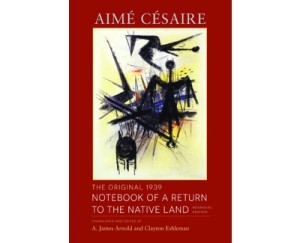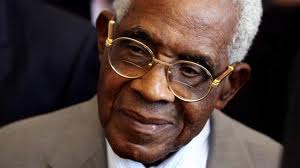by Carol Cooper
The Original 1939 Notebook of a Return to the Native Land (Wesleyan University Press) $24.95
By Aime Cesaire (Translated and edited by A. James Arnold and Clayton Eshleman
 “I would come to this land of mine and I would say to it: “Embrace me without fear…And if all I can do is speak, it is for you I shall speak.”-Aime Cesaire (1939)
“I would come to this land of mine and I would say to it: “Embrace me without fear…And if all I can do is speak, it is for you I shall speak.”-Aime Cesaire (1939)
There are books, and then there are BOOKS: works of literary art that are so distinctive and important that they have a lasting impact on everyone who reads them. Sometimes this lasting impact is due to the fame of the people who wrote them, or the way in which they were written, or the subjects they discuss, or if and how they were illustrated. In the case of a new edition of the original 1939 version of Aime Cesaire’s “Notebook of a Return to the Native Land,” all the aforementioned reasons qualify it as a BOOK not to be missed by anyone who loves to read.
Cesaire’s long meditation on how it felt to be a colonial French Afro-Caribbean intellectual temporarily living in Europe during World War II was, like most rap music, written around the rhythm of the human heartbeat. Published ten years after the ambitious Pan-African agenda of Marcus Garvey succumbed to ideological sabotage and economic imperialism—just before a stock market crash threw America into the Great Depression—“Notebook” was about how a man might find his true identity and cultural power in a world undergoing radical social change.

Every version of this prose poem ever published has been an international phenomenon. Cesaire and his family left Nazi-occupied France to return to Martinique the same year the avant-garde magazine Volontes publishes “Notebook.” Yet in 1942 a different, more overtly political, version is celebrated by the prominent surrealist Andre Breton, who escaped to Martinique from France in 1941. In 1942 Cuban cultural anthropologist Lydia Cabrera published her Spanish translation of the 1939 version, including Afro-Cubist drawings by Chinese-Cuban expat Wifredo Lam. A long-promised English language version first emerged in New York in 1947, followed by yet another French revision published that same year in Paris. Then in 1956 Cesaire offered a fourth reconfigured copy of this landmark work, replacing many of his original earthy, sexual metaphors with more lucid political ideas. It was again translated into multiple languages.
The current bilingual edition is a hardcover from Wesleyan University Press, freshly translated from the French and edited by A. James Arnold and Clayton Eshleman. What these two scholars have managed to do is restore to the world one of the great long narrative poems of the Post World War II era in all its political urgency and emotional intensity. They have included in this slender volume all the lost Wilfredo Lam drawings, special inscriptions added to different editions, a comprehensive timeline of key events in Aime Cesaire’s life; and revelatory notes about the poem itself.
During the 1930s, Cesaire (who would go on to become president of a free, post-colonial Martinique), was a student in Paris along with his wife Suzanne and dozens of other brilliant black kids from France’s overseas colonies. In the 1940s, he and Suzanne founded the literary magazine Tropiques to showcase the creative work of poets and artists from Francophone Africa and the French-speaking Caribbean. Why? To demonstrate their intellectual originality. For as A. James Arnold tells us in his introduction to this book: “In Cesaire’s view, colonial society had been impeded from developing its own original forms and institutions by the imposition of French cultural norms on a population transported from Africa.” This is not to say that Cesaire didn’t respect and immerse himself in cultures other than his own. One of the many marvelous facts you learn in this book is that in 1969 Cesaire took time to adapt Shakespeare’s play The Tempest for a black theater company so that Caliban could be seen as a revolutionary Malcolm X, and Ariel as an accommodating Dr. Martin Luther King.